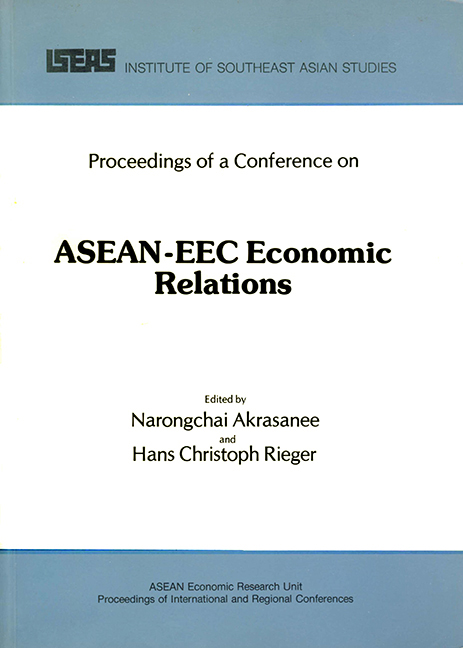Book contents
- Frontmatter
- Contents
- FOREWORD
- BUILDING BRIDGES AND OPENING DOORS
- 1 TRADE
- ASEAN-EC Trade Relations: An Overview
- Trends of EC Protection and the Prospects of ASEAN Trade
- Issues Relating to the EC's Imports of ASEAN Primary Products
- ASEAN Manufactured Exports in the EC Markets: An Empirical Assessment of Common and National Tariff and Non-Tariff Barriers Confronting Them
- A Constant-Market-Shares Analysis of ASEAN Manufactured Exports to the EC
- II INVESTMENT
- APPENDICES
ASEAN-EC Trade Relations: An Overview
from 1 - TRADE
Published online by Cambridge University Press: 21 October 2015
- Frontmatter
- Contents
- FOREWORD
- BUILDING BRIDGES AND OPENING DOORS
- 1 TRADE
- ASEAN-EC Trade Relations: An Overview
- Trends of EC Protection and the Prospects of ASEAN Trade
- Issues Relating to the EC's Imports of ASEAN Primary Products
- ASEAN Manufactured Exports in the EC Markets: An Empirical Assessment of Common and National Tariff and Non-Tariff Barriers Confronting Them
- A Constant-Market-Shares Analysis of ASEAN Manufactured Exports to the EC
- II INVESTMENT
- APPENDICES
Summary
This essay provides an overview and a framework within which detailed discussion on trade relations between the Association of Southeast Asian Nations (ASEAN) and the European Community (EC) may be carried out. The emphasis will be more on ASEAN's point of view of the trade relations.
The EC is ASEAN's major trading partner after Japan and the United States. The EC accounts for about 14 per cent of the total ASEAN trade on both the export and the import sides. This proportion has remained fairly constant over the last few years, implying that ASEAN's trade with the EC has been increasing in line with total ASEAN trade, which has been growing very rapidly by world standards. Since trade is a very important component of the ASEAN economies, it follows that ASEAN's trade with the EC has significantly contributed to the development of ASEAN.
On the other hand, to a very large economy like the EC, ASEAN appears insignificant. The EC's exports to and imports from ASEAN have never exceeded two per cent of its total exports and imports. However, ASEAN's exports to the EC are highly specialized and the EC relies heavily on ASEAN for such items as rubber, timber, tapioca, tin, palm oil, and cattle feed. The pattern of trade becomes even more specialized when broken down according to country. Thailand and the Philippines are the major sellers of tapioca and copra respectively to the EC. Indonesia and Malaysia are more important to the EC as importers, but they are also major suppliers of rubber, timber, tin and palm oil. Singapore exports manufactured goods and electronics to the EC. More recently ASEAN textiles have made a breakthrough in the European market with such success that the EC has set limits on textile imports from ASEAN. Other ASEAN manufactured goods are also beginning to appear in the European market.
- Type
- Chapter
- Information
- ASEAN-EEC Economic Relations , pp. 10 - 51Publisher: ISEAS–Yusof Ishak InstitutePrint publication year: 1981

